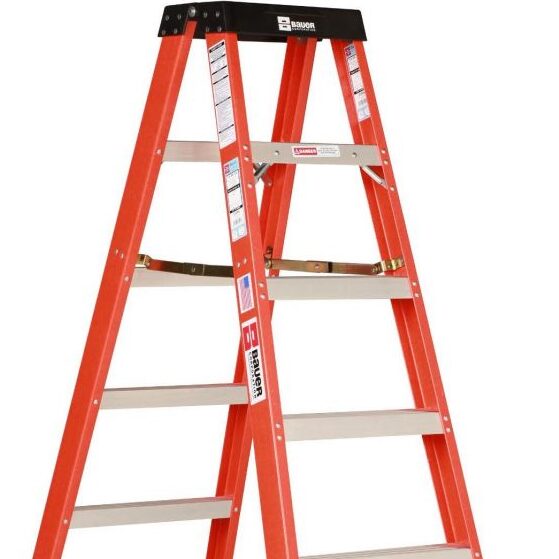Choosing the Right Ladder for Each Job: Being Sure of Yourself When You Climb Up One of those simple-looking but essential tools that help us reach our home-building goals and discover new things is the ladder. The many types of ladders on the market can be confusing for people who like to do their fixes. Don’t worry, though! This complete guide straightens out the ladder maze so you can pick the right climbing partner for any job, like getting to the top of a tall shelf or beating those annoying alley demons.
How to Understand Ladder Lingo: How to Get Out of the Jargon Maze
Let’s clear up a few essential terms before you start your ladder adventure: The stable base and wide steps make it easy to climb. It’s your best friend for home projects. This is like your trusty horse that you can use to do things like improve your tables or change your light fixtures. No matter how high the roof is, this wonder will help you reach for the stars. The rocket ship can take you up high to paint tall buildings or clean ditches that are hard to get to.
This tool looks like a chameleon because it can be changed into a stepladder, an extension ladder, and a scaffold base. It’s excellent for many jobs when you need more space to store things. Climbing is like having a Swiss Army knife that can do many things. The stage has plenty of space and comfort, and there are guardrails to make it safer. It’s like your cloud; it keeps you safe while you work on long jobs like painting or roofing. Fibreglass is excellent for electrical work because it keeps heat in. Aluminium is the best because it is strong and light. Fibreglass is like a rocket that is safe, and aluminium is like a fast runner. They can all do different things well.
Ladder Length: Don’t Rush!
It’s essential to choose the right ladder length. Don’t forget that “standing on the top step” is unsafe! When you need to reach something, multiply that number by your height plus one foot to get the platform height. Say you’re 5’10” and need to paint a 10-foot ceiling. It would help if you used a 17-foot ladder. For example, getting the correct shoe size ensures that your job fits well and is safe.
Always put safety first! It’s important to keep your ladder on safe, level ground, fully stretched, and locked in place at all times. If the ground isn’t level, use levellers. Also, please don’t put too much on the ladder at once, and never lean it against something that isn’t stable. Putting on your seatbelt before every rise is like that—you have to do it for safety and comfort. You could buy a ladder stabilizer to give yourself more peace of mind, especially if you choose to work alone. It’s like flying with a co-pilot.
This site helps you discover the best ladder for your needs.
Let’s get you on the right ladder now. For a safe and comfortable place to work, pick a platform ladder or a ladder that can be rotated. Imagine moving quickly across the wall, where you feel safe, and letting your brushstrokes flow. You can quickly get to any hard-to-reach spot with an extension ladder and a stability ring. It’s like cleaning out your drains without having to do any risky turns or bends. For more safety while working up high, you should get a multi-position ladder with a stand-off feature. It’s like having a safe viewing deck so you can trust the cuts you make. It is easy to do many things inside when you have a stepladder that you can use for different things. It’s like a reliable partner who is always ready to help you when you need to change the light bulbs or get to that high closet.
Beyond the Basics: More Advanced Features of the Ladder
These features are worth thinking about for people who have done this before or who are working on unique projects. It’s like a quick tank that can take over any fight and is easy to change to rough terrain. Dig into the soft ground outside to get a better grip. It sticks to objects like an anchor and gives you a firm grip. It gives you more support for higher jobs, like a big stage that makes you feel safe while you work at heights. Stop shaking for extra peace of mind. It’s like having an extra safety belt that helps you stay steady as you climb.
How to Take Care of Your Partner’s Ladder As You Climb
Keep your ladder in good shape, and it will always be a good friend. Clean up any dust or dirt, check for damage, and grease any parts that move every so often. By properly storing your ladder, you safeguard it from adverse weather conditions and any hazards. It would be beneficial if you prioritized self-care with the same level of attention and concern as you would for your closest companion. Regular checkups and a safe place to stay will help you climb for a long time. To sum up, feel good about improving your do-it-yourself skills. If you choose the right tool for the job, you can move up the ladder with confidence now that you know what this guide has taught you.
FAQs:
What can I use a stepladder for outside?
Step ladders are versatile and can be used both inside and outside. Prior to using the ladder outside, ensure that it is placed on a stable and secure surface.
How often should I look over my stepladder for damage?
Before you use your ladder, check it over again, and do that more often, at least once a month.
Can I paint my ladder the same colour as my house?
You can paint your ladder in shades and patterns that match the rest of your house. Make sure that the paint doesn’t make the ladder less intense.
How much weight can a normal extension ladder hold at most?
Different extension ladders can hold different amounts of weight, so always read the directions that come with the ladder. Up to 300 pounds can be put on most home extension ladders.

